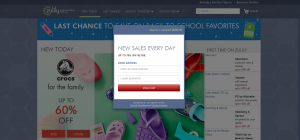Zulily’s Sale to QVC Reveals the Failure of This All-Too-Common Web Marketing Tactic
Why zulily failed:
Your daughter’s feet have outgrown her shoes again. You toss her old shoes in the hand-me-down basket, and wonder where the next pair will come from. You heard about zulily’s awesome selection of kids clothing and low prices, so you deci de to check it out.
de to check it out.
You come to their site looking for children’s shoes. You want to see pictures. You want to see prices. You want to see sizes and options. You want to buy today, and you’re comfortable making online purchases.
Even though you’re a brand new customer, you’re arriving at zulily ready to buy.
But when you arrive at the site, you see it – the email form. You start clicking around it. At some point, you wonder in exasperation:
“Can’t I view the site before giving my email?”
You’re just not in the mood to hand over an email to yet another website without first seeing if they have want you want.
You click around a bunch more. Is this is really the right site? Dumbfounded that there is literally no way to even look at the site without handing over your email, you purse your lips, sip your coffee, mutter “whatever,” and decide to shop at Amazon.
Violating Basic Online Marketing Principles
Businesses rise and fall all the time. And it’s complicated.
But the sale of zulily to QVC – for one third its 2014 valuation – offers an opportunity to explore the power of basic online marketing principles.
First off – let’s not delude ourselves into thinking the sale of Seattle-based zulily to QVC represents anything other than a failure of their business model. One-third their valuation. Wall Street analysts admitting they were wrong about recommending the stock. This sale is not a success. The key is to take a moment to learn why zulily failed.
And people may disagree about which aspect of zulily’s model may be most responsible.
Their Unique Value Proposition was Not the Problem
A Seattle Times article suggests the reason why zulily failed was the longer-than-average shipping times that frustrated buyers who are used to instant everything.
But zulily says that’s what you trade for the extra low prices and extremely wide and ever-shifting selection. Not having to stock inventory seems like a plus. So I’m inclined to agree with zulily on this.
As a buyer, if I know there’s no other place that offers the unique selection and low prices I find at zulily, I will put up with longer shipping times. The unique value proposition of zulily is their diverse and ever-changing selection. Not one-day shipping. People who gripe about shipping aren’t their target market. Those people are Amazon drones already.
So then, what caused zulily’s sales to fall so hard?
As the hypothetical story above shows, the failure of zulily happened because they overlooked a basic principle of web marketing:
What problem does the user bring to your site, and how do you help them solve it?
In zulily’s case, they chose to force all their prospects to engage with their site on their terms – and only their terms. They made it a requirement that before you can do anything, you will give us your email. No exceptions.
Here’s zulily’s welcome mat, also known as a home page:
As recently as 2017, this is still how zulily welcomes ALL new visitors.
You can’t click anywhere. You can’t browse. You can’t compare. You can’t search. You can’t even buy! Before doing anything, you must give them your email.
This is likely the number one source of their failure to grow at the rates Wall Street expected.
Why? How do I know this?
Web Visitors Care About Their Needs, Not Yours
Internet users always come to a site with all kinds of needs. All kinds of expectations. They come with problems, and they’re hoping you can solve them. For zulily, their prospects could come with problems such as:
- My kid’s growing fast, and I need new clothes
- I want to find clothes no one else has
- A friend told me about zulily, and I’d like to see how they compare to where I usually shop
- I just got a bonus, and want to surprise my wife with a bunch of gifts
- School’s just around the corner; my son’s entering high school and wants a new wardrobe
We could probably come up with 50 more. And if you could somehow come up with every possible problem a potential zulily customer might bring to their site, how many of them will include this one?
- I need to give my email address to another online business
None!
Nobody goes to a website and wants to do this as their first action. Nobody. Even if a friend had referred them to the site, if you asked that person what they wanted to do first when they got to the site, it would never be, “give them my email.”
More importantly, a huge percentage of website visitors (29% according this 2010 econsultancy article) do not like giving their emails to companies, ever. Even when they buy something. And the reasons are obvious – spam, marketing they don’t want, non-interest, not wanting to commit to something, and of course, online privacy.
These are all legitimate concerns of real people. And zulily has basically looked at that 29% of people and said,
“We don’t care. If you want to even look at our site, you will give us your email.”
The thing I don’t get is, why do it this way? In theory, you don’t ever need a person’s email to sell them something online. Now, it’s not bad to ask for it. And most people are used to things like online receipts and updates and email coupons. So when they buy, most people probably will give their email.
But to make this a step 1 requirement, when really it should be an option somewhere around step 10, is really baffling.
Was Zulily’s Web Marketing Strategy Working?
In just a couple years, their subscribers went from 2.6 million to over 5 million. Seems like growth. However, sales were slowing down, which means their subscribers weren’t buying as much as people expected.
Why is that? Could one reason be that a majority of those subscribers were never committed to zulily in the first place, and ignored all or most of their email marketing?
On the flip side, what if they had been able to gain 7 million subscribers? Or 10 million?
How many subscribers would zulily have if they had not made subscribing a requirement to even look at their site?
Think about that question for a moment. What if they incentivized people to sign up, rather than force them to? Use effective copywriting and lead capture to give people a reason to join their email list?
Right off the bat, that approach gives you a list filled with expectant subscribers — “What kinds of deals will I get?” — verses resigned subscribers — “I only signed up because I had to, so I don’t really care.” This is a huge difference!
Currently, it is impossible to buy anything from zulily until you give them your email. So, how does this requirement help sales? It’s a needless barrier.
And keep in mind, ProActive Content is all in favor of email marketing. It’s one of our primary services. Building a subscriber list, and then nurturing it through lead generation, opt-ins, autoresponders, and targeted, segmented email marketing, is a proven way to build customer loyalty. But those things all happen after someone decides they want in.
How many new customer needs went unaddressed because people refused to conform to the only way zulily gave them to engage with their site?
How many people refused to participate and just left?
How many gave bogus email addresses just to see the site, and then never read a single email?
This approach defeats the whole purpose of getting their email – the point of building a subscriber list is that you generate a list of people who are interested enough in your product to let you send them emails about it. It’s voluntary. But, how can they be interested if they can’t even see your products?
If zulily’s product really is as innovative, popular, and unique as people say (I can’t say, because I haven’t given them my email), then it’s possible their 5 million-strong subscriber list could have been 10 million.
Again, this is web marketing 101. You don’t force visitors to engage with your site the way you want them to. You enable and empower them to use it the way they want – the way that will help them solve the problem, answer the question, and meet the need they came with.
It’s an email opt-in form. Not a an email “force-in” form.
It’s about the user. Not the company.
Does your website have hidden roadblocks like this that maybe you’ve overlooked? They aren’t always as obvious as zulily’s.
Discover the symptoms that may be inhibiting your growth, and the solutions to remedy it.



